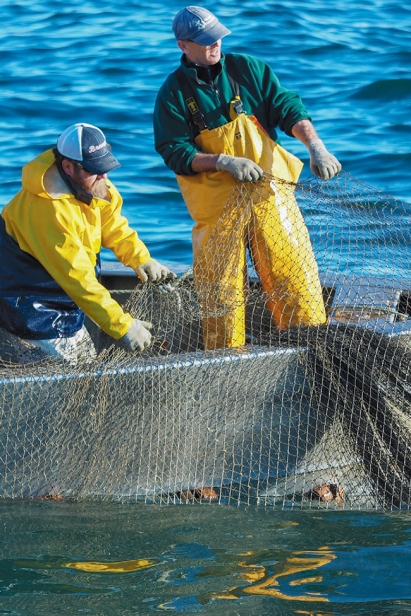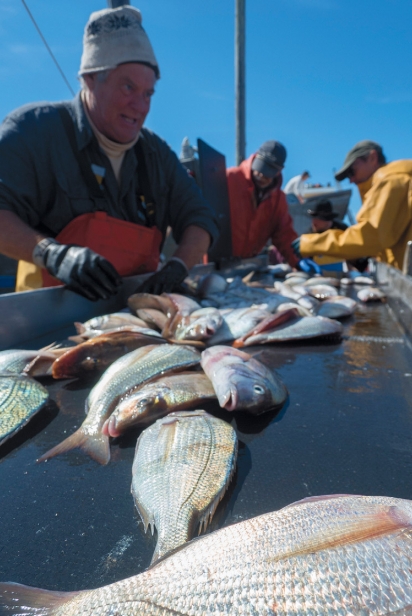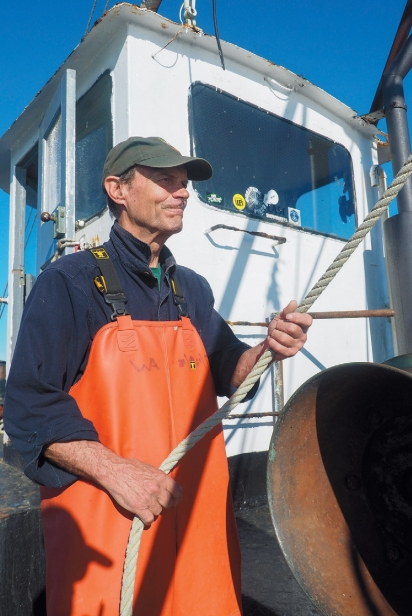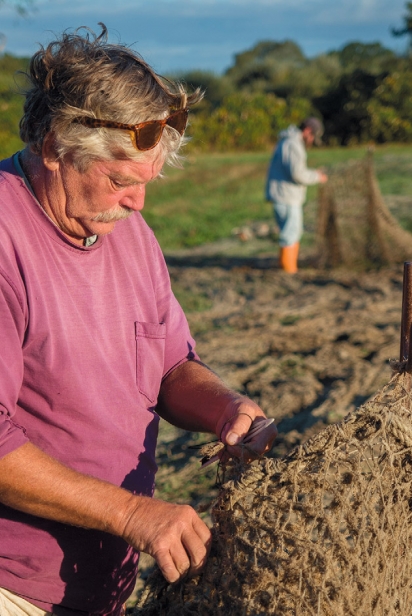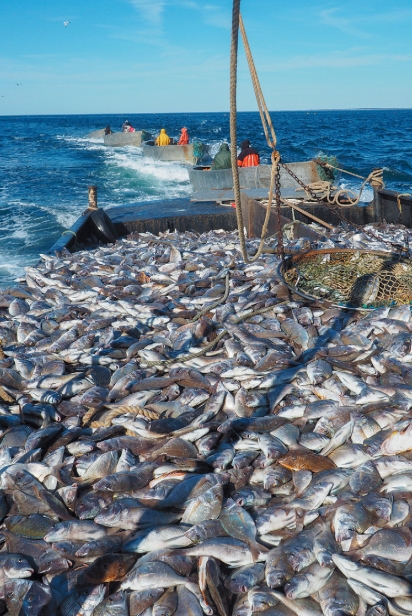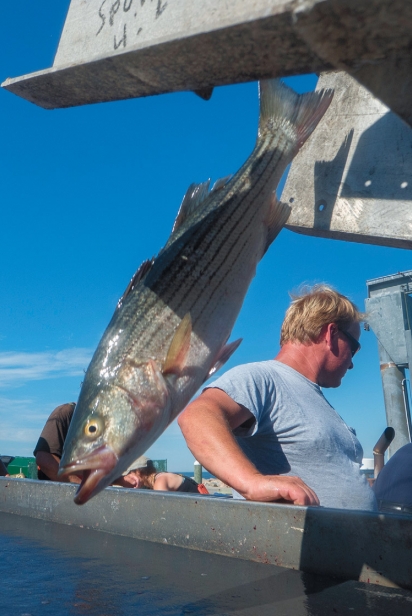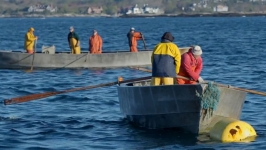Pulling Twine with the Wheelers
A Rhode Island Family Remains Dedicated to the Art of Trap Fishing
Corey Wheeler Forrest is a third-generation Sakonnet Point fish trapper and fish dealer, who, at age 40, works right alongside her brother and father on their trap boat, the Maria Mendonsa.
“I grew up as a little girl hearing my grandfather and father talk about fish, weather, the nets. It’s the same thing today: Our conversation revolves around fish and work. It’s who we are,” says Corey.
During the fishing season, which can last from April to October, Corey, brother Luke Wheeler, 43, and father Alan Wheeler, 70, wake up around 4 am and drive from the top of Aquidneck Island down to Sakonnet Harbor in Little Compton. They all leave from the same property, a piece of land with four houses on it that has been in their family since 1900.
Alan and his wife, Bobbie’s, three kids—Luke, Corey and Miles—all went to Portsmouth High School.
“Growing up, when we were kids, our house was the place to hang out,” says Corey. “We had a huge lobster pot fort with tunnels through it. Nets to jump off. We had a skate ramp. The whole neighborhood would be over.” Younger brother Miles Wheeler, 34, now lives in Florida with his family, and comes north in the summer on vacation to fish and hang out where he grew up.
The early Wheelers on Aquidneck Island farmed and dug clams. “That’s what people did back then,” says Alan. “My father trucked vegetables and then started trucking fish out of Newport. He bought the Sakonnet Point trap company in 1947.”
Fishing families are rare in Rhode Island, with a few out of Point Judith, and a few up the Bay. Fishing is not easy. Current regulations and operating costs make it hard for those in the business to stay afloat. The Wheelers are three generations into fish trapping with little sign of giving up.
“Our father gave us other opportunities,” Corey says. “Fishing wasn’t forced onto us. I went to college and studied literature, my brother Luke went to Maine Maritime Academy. I figured I was just going to fish in the summer and then teach. But now I wouldn’t go back. I love what I do.”
THE FLOATING FISH TRAP
Although it is it rare to come across a family that works together over generations, the way the Wheelers harvest fish is even more rare. There are only four trap companies left in Rhode Island, down from approximately 200 in the late 1800s.
The floating trap, as it is called, is unique to Rhode Island and has a long history in the state. It is designed to catch fish that are moving and works best on schooling fish like scup, striped bass, butterfish, bluefish and bonito.
“In a lot of [types of ] fishing it’s the boats that move around,” says Luke. “They follow the fish. In trap fishing, we can’t move. The fish have to come to us.”
The trap has four components: the leader, the wings, the frame and the net itself. The leader is a long wall of webbing that leads the fish, guiding them down into the trap. This leader, on the Wheelers’ big net off Newport, near the end of the Cliff Walk, is about 1,200 feet long. After the leader comes a series of funnels, called wings. The funnels act like the inside of a lobster trap, making it hard for the fish to escape. At the end of the last funnel is the actual trap, essentially a box made of twine, 60 feet long by 60 feet high. This is where the fish end up. The whole arrangement is held off the bottom by 26 (900-pound) individual anchors. It is complicated and unwieldy to work with in rough seas and poses its challenges even on calm days.
“I’ve been doing this a long time and I’ll still get confused sometimes. Especially when we are setting in the spring. There’s a lot going on,” says Luke.
To make a trip with the Wheelers and steam out of Sakonnet Harbor is to take a trip back in time. “Not much has changed from the way we fish now to back when this [trap fishing] began,” says Alan.
There are no hydraulics. The 30-feet-long skiffs that are towed out behind the Maria Mendonsa, on the way to the nets, have no engines. They need to be either rowed or sculled. When the skiffs are circled around the trap and the net is hauled, called “pulling twine,” it is literally that—hand-over-hand, the entire crew pulls and pulls. Some wear gloves, some do not. Some talk, others are silent. It has a rhythm to it, the air around the boats smells strongly of salt, seaweed and fresh fish.
“I love hauling trap,” says Alan. “Everything about it I love. The boats, the fish. Just being there.” Alan’s dad, George, fished until a few weeks before he died at 87. “That’ll be my dad,” Corey says. “He’ll be out here until he physically can’t.”
Alan, who loves to be down in the skiffs with the action, keeps the pace. Corey pulls twine near him. Luke, who takes on more of a captain’s role, stays with the Mendonsa and readies the boat for fish. As the crew pulls twine and the net is made smaller and smaller, the first fish begin to show themselves, up on the surface, in boils and swirls.
This fishery, it can seem almost like a museum in motion, an idyllic slice from yesteryear, something to photograph. But when the fish are running, the preservation of a lifestyle is probably not foremost in the minds of the captain and crew:
“We catch and sell fish,” says Alan. “That’s our job.”
OFF TO MARKET
In the spring, when Rhode Island fish trappers tend to have their best sets, the scup can come thick. The scup run in April and May is a key crop for the Wheelers, along with striped bass. Scup look like silver-scaled freshwater sunfish, and taste sweet. Corey, who handles the fish sales, sends the bulk of the scup, which can easily be more than 20,000 pounds a day for weeks on end, to New York, Maryland and South Carolina. When the net is full of scup, the twine is heavy in the hands. At the surface, the fish froth about, and send spray into the crews members’ faces. As Corey says, “Once the scup show up, we won’t stop, week after week. By the end of the scup run you’re pretty fried.”
On the way back to the dock, Corey texts her buyers. Being a fish seller is a new gig for her. She sells the trap-boat fish and the fish her brother Luke catches on the side. Luke works his own boat to make extra money, targeting species like monkfish, fluke and sea bass. Corey handles the same markets her grandfather handled. On her phone she tells her customers what she has: the species, amount and price.
“Selling fish is more stressful than I had thought,” says Corey. “You have people relying on you, you have relationships to tend to. It has definitely taken some of the romanticism away—but not all of it. We see some incredible stuff out here.”
It’s hard to find fresher fish than what comes off the Maria Mendonsa. For one, the boat is back at the dock by roughly 9:30 every morning and the fish are off to market soon thereafter. And second, the fish are harvested when they are fully alive and jumping.
Another selling point for trap-caught fish is how easy it is to release unwanted fish, or any fish they can’t sell. Those fish can be tossed overboard individually or, if there are many, the floats along the top of the net can be sunk and the fish will swim out over the top.
“It’s green,” says Luke. “It is definitely a good way to harvest fish and our customers know that. Trap-caught fish almost sell themselves.”
Making a living in trap fishing isn’t easy. All fishing is unpredictable and full of uncertainty. Stocks change, fishing pressure east of Nantucket has an impact on the fishing off Rhode Island. The warming ocean has an impact; so do fish prices, fuel prices and the list goes on.
“It’s hard work to keep it going,” says Alan. “A lot of people have gotten out of it. But I think it’s worth holding on to. We feed people. That’s important.”
To learn more about the Wheeler Family and to take an up-close look at the art of trap fishing, watch our Edible Rhody Minute video at EdibleRhody.com.



